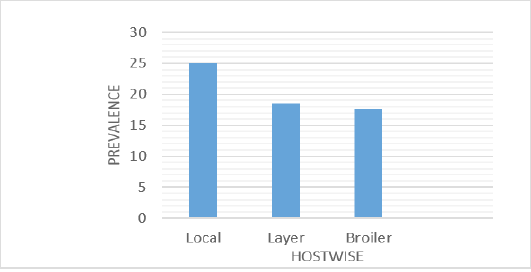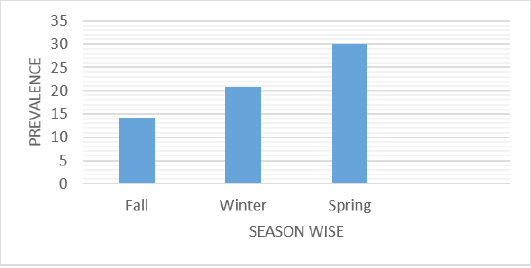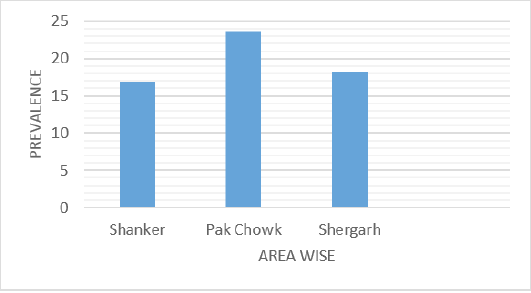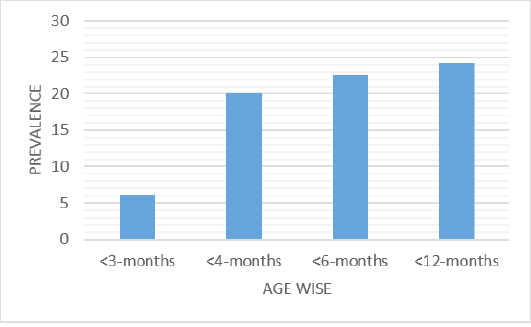The Journal of Advances in Parasitology
Research Article
Prevalence of Ascaridia galli in some Poultry Farms of District Mardan
Lal Zada1*, Tahir Rehman1, Sadaf Niaz1, Muhammad Aurang Zeb2, Bibi Ruqia1, Salma1, Mir Alam Khan1, Abdullah Khan1
1Department of Zoology; 2Department of Biochemistry, Abdul Wali Khan University Mardan, Pakistan.
Abstract | This study was conducted from September 2013 to march 2014 to find out the prevalence of A. galli in some poultry farms of district Mardan. During this period total of about 751 chicken intestines were collected and examined for the presence of A. galli. In these 751 about 161 were infected and the overall prevalence rate of A. galli was about 21.44%. In this study total 360 local chicken were examined in which 90(25%) were infected. 221 layer chicken were examined in which 41(18.55%) were infected and about 170 broiler of which 30(17.64%) were infected. The overall study show that A. galli is the most common and highly prevalent nematode in the chicken of district Mardan. The study also shows that A. galli is common health problem in both free ranging and poultry chicken so suggest the need of proper poultry management.
Keywords | Prevalence, Poultry farm, Chicken, Ascaridia galli, Mardan
Editor | Muhammad Imran Rashid, Department of Parasitology, University of Veterinary and Animal Sciences, Lahore, Pakistan.
Received | November 03, 2015; Revised | December 06, 2015; Accepted | December 07, 2015; Published | December 19, 2015
*Correspondence | Lal Zada, Abdul Wali Khan University Mardan, Pakistan; Email: lalzada.awkum@gmail.com
Citation | Zada L, Rehman T, Niaz S, Zeb MA, Ruqia B, Salma, Khan MA, Khan A (2015). Prevalence of Ascaridia galli in some poultry farms of district Mardan. J. Adv. Parasitol. 2(4): 75-79.
DOI | http://dx.doi.org/10.14737/journal.jap/2015/2.4.75.79
ISSN | 2311-4096
Copyright © 2015 Zada et al. This is an open access article distributed under the Creative Commons Attribution License, which permits unrestricted use, distribution, and reproduction in any medium, provided the original work is properly cited.
INTRODUCTION
The poultry area is one of the most organized and well growing sectors of the agriculture industry of Pakistan. The employment and income for about 1.5 million people is generated directly and indirectly by this area. The contribution of poultry in agriculture and livestock is 6.4% and 11.5%, respectively. Nowadays the income of Pakistan poultry industry is about Rs. 564 billion (Memon, 2012). So the production of poultry plays an important role in the economy as a source of income for both large and small farm holders (Ogbaje et al., 2012). In the entire poultry population above 98% are the domestic chicken (MALDM, 2000).
The infection of local chicken by endoparasites is more common due to their free-ranging mode of life (Ondwassy et al., 2000). Ewen in 1980 estimated that the most important challenge, which hinder against poultry farming are parasitic diseases. This parasitic diseases cause reduce growth, effect egg production, emaciation and anemia also cause death (Whitmarsh, 1997; Kaufman et al., 2007). The most common disease caused by helminthes parasite in poultry is Ascaridiosis (Fatihu et al., 1991). Ascaridiosis a disease mainly caused by Ascaridia galli, which is a nematode parasite and worldwide problem in all poultry systems mostly free is ranging forms (Ruff, 1991; Permin et al., 1998). A. galli specially restricted to small intestine of bird (Yamaguti, 1961) such as chicken, turkey, geese, guinea, fowl and wild bird in most part of the world (Ackert, 1931; Kates and Colglazier, 1970; Soulsby, 1982; Anderson, 1992).The principle host being the chicken (Ackert, 1931; Kates and Colglazier, 1970). A. galli infection cause loss of weight, anorexia, hemorrhages in the intestinal mucosa, obstruction of the intestinal lumen (Ackert, 1931; Ikeme, 1971) reduction in growth retardation, reduced feed production rate, loss of appetite, blood lose anemia, diarrhea and secondary infection due to damage of intestinal mucosa (Ackert and Herrick, 1928; Ramadan and Abou Znada,1991). Drooping wings, decrease egg production (Ackert and Herrick, 1928). These symptoms are more common in those chickens when their age is about 3 months (Kaufmann et al., 2011). The worm can be directly identified by post mortem diagnosis method (Soulsby, 1982) or by the examination of faecal samples or by cutting of intestine “post mortem” (Taylor et al., 2007). The aim of this survey is to find out the prevalence rate of A. galli in poultry farms of district mardan.
MATERIAL AND METHODS
Study Area
The survey covered some parts of District Mardan like Pakistan Chowk, Shankar and Shergarh.
Observation Period
The study was conducted from September 2013 to March 2014. During this period total of about 751 chickens were observed including Broiler, local and layer chicken of different age, sex, area and season for the presence of adult helminthes parasite (A. galli). By common method the age and sex of chickens were find out by asking from workers and attendants in farms and slaughter houses. Whereas sex of chickens was determined by Jett method (2011) while the chicken were categorized into four groups on the basis of method proposed by Magwisha et al. (2002).
Samples Collection and Procedure of Examination
The chicken were slaughtered and carefully observed. The gastrointestinal tract was taken out from the body carefully and removes the junction between the intestines. Double ligature were applied to prevent the mixing of contents between different parts. Removed the external membrane which help in the folding of intestine, then opened it with the help of scissor through a longitudinal cut and observed its contents for the adult parasite by washed, decanted and sediment it (Eisa et al., 1976).
Parasite Identification: Adult worms were identified according to the method given by Dunn (1978) and Soulsby (1982).
Preservation: The adult parasite were separated, collected with forceps and preserved in 10% formalin.
RESULTS
Overall Prevalence
Total 751 birds (chicken) were examined of which 161 chicken were infected with A. galli. The overall prevalence rate was about 21.44% with a range of 5-30%.
Host Wise Prevalence
360 gastrointestinal tracts of local chicken were examined of which 90 were infected so the prevalence rate was 25%. 221 layer chickens were observed for the presence of A. galli of which 41 were infected having the prevalence rate as 18.55% and 170 Broiler of which 30 were infected with the prevalence rate of 17.64% (Figure 1).
Season Wise Prevalence
In relation to seasons the prevalence rate in fall season was 14.28%. In winter it was about 20.84% and in spring the prevalence was reached to 30.00% (Figure 2).

Figure 1: Host wise prevalence of A. galli

Figure 2: Season wise prevalence of A. galli
Month wise prevalence
The prevalence rate from September to March (2013-2014) was 14.28%, 5.88%, 17.91%, 16.44%, 23.64%, 24.20%, 29.20% respectively (Figure 3).

Figure 3: Month wise prevalence of A. galli
Gender Wise Prevalence
Three hundred thirty out of 751 were male and 421 were female observed. Prevalence rate in female were 24.26% while in male 16.66% (Figure 4).
Area Wise Prevalence
Data was collected from the Pakistan Chowk, Shankar and Shergarh of District Mardan .each place having different prevalence rate such as (23.61, 16.95, 18.27) percentage respectively (Figure 5).

Figure 4: Gender wise prevalence A. galli

Figure 5: Area wise prevalence of A. galli

Figure 6: Age wise prevalence of A. galli
Age Wise Prevalence
Prevalence rate in different age of chicken were <3 months (6.12), <4 months (20), <6 months (22.55) and <12 months (24.18) in percent (Figure 6).
DISCUSSION
The data that has been derived from 161 infected chickens out of 751 showed that the overall prevalence rate of 21.44 %, which is nearly equivalents to 20% in Switzerland reported by (Permin, 1997) less than 25.63% in Kenya by (Kaingu et al., 2010) 25.7% in Pakistan by (Sayyed et al., 2000) and 32.89% in Khartoun State, Sudan by (Hanan et al., 2005). But greater than 10.03% in Kenya by (Kimani et al., 1999) 7% in Germany, 3% in Bavaria according to (Permin, 1997). The variation in overall prevalence rate are due to the climatic condition contributes in developing of infective stage, difference in chickens immunity of various locations that resist against establishment of A. galli, and the use of anthelmintics such as piperazine, hygromycin B and Fenbendazole drug that kills the parasites. The prevalence rate is quite different among various areas due to the wide range variations in locality and environmental factors. The infestation rate in local chickens was 25% which is greater than 17.64% in India by Channa et al. (2004) and less than 32.38% in Iran by Naem and Skandari (2004). Local chickens are more prevalent to infestation because of their free-ranging mode of life, scavenging behaviour, less veterinary care and poor sanitary conditions. As they seek food from superficial layers of soil, so there is great chances of ingestion parasitic eggs and faecal contaminated food, water, litter or by eating paratenic hosts such as grasshopper and earthworm. The prevalence in broiler and layer is 18.25% and 17.64% respectively .This is lower than 35.7% in broiler and greater than 5% in layer by Ogbaji et al. (2012). The infestation rate in broiler is low might be the regular use of anthelminthic on the farm and also short lifespan. The infestation rate in fall, winter and spring is 14.28%,20.84% and 30% respectively because humid and cool environment is good for survival of parasitic stage and helps in transmission (Kenndy, 1975; Audu et al., 2004) while moderate climatic conditions is ideal for but heat, desiccation or direct sunlight may kill the larvae of A. galli.
The research survey demonstrate the prevalence rate in female and male 23.58% and 16.96% respectively which is against the infestation rate given by Ekpo et al. (2010). From the study of local and exotic chickens in Nigeria, Matur et al. (2010) concluded that females are more susceptible to infestation than male by helminthes parasites due to voracious feeding nature of female while male is selective in feeding habits.
The age wise prevalence obtained from result is < 3 ,4,6 and 12 months with prevalence rate of 6.12%,20%,22.5% and 24.18% respectively .The increase in infestation rate as age of host increases might be due to their long introduction and exposure to environmental conditions facilitate the chances of ingestion by contaminated food or polluted drinks.
CONCLUSION
This study show that the infection of A. galli is more common in local, layer and broiler chickens in district Mardan. The A. galli is more prevalent parasite in poultry. It mainly affects the health of chickens and cause great economic loss. This study suggested that to improve the poultry management and sanitary conditions in poultry houses or farms.
ACKNOWLEDGEMENT
We are thankful to Department of Zoology, Abdul Wali Khan University Mardan for providing Facilities to conduct research.
COMPETING INTEREST
We declare that we don’t have any competing interest.
Authors’ contribution
Lal Zada, Tahir Rehman, Bibi Ruqia, Salma, Mir Alam Khan and Abdullah Khan carried out the experimental work and analysed the data. Sadaf Niaz provide technical support and guidance. Muhammad Aurang Zeb wrote the manuscript, gave the constructive feedback and suggestion, also help in data analysis.
REFERENCES





